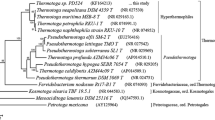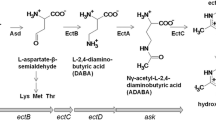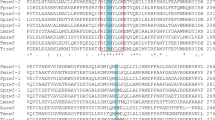Abstract
Pseudomonas sp. strain MC1 was characterized as a cold-adapted, naphthalene-degrading bacterium that is able to grow in a broad temperature range of 5–30°C. MC1 harbors a catabolic plasmid, designated pYIC1, which is almost identical to the archetypal NAH7 plasmid from the mesophilic bacterium Pseudomonas putida G7. On pYIC1, the catabolic genes for naphthalene degradation are clustered in two operons: nahAa-Ab-Ac-Ad-B-F-C-Q-E-D encoding the conversion of naphthalene to salicylate, and nahG-T-H-I-N-L-O-M-K-J encoding the conversion of salicylate through meta-cleavage pathway to pyruvate and acetyl CoA. NahH, the bona fide extradiol dioxygenase in MC1 salicylate metabolism, is thermolabile and is a cold-adapted enzyme. The thermal profiles of the NahH enzyme activities expressed in different hosts indicate the presence of a factor(s) or mechanism(s) to protect the thermolabile NahH enzyme (100% aa identity with MC1 counterpart) in G7. Overall, the results reported in the present work suggest that the thermolabile NahH might be a product of the cold-adaptation process of MC1 and thus contribute to the survival and growth ability of MC1 on salicylate and naphthalene in cold environments.






Similar content being viewed by others
References
Ahn E, Kim D, Kim E (2012) Complete sequencing and comparative analysis of a NAH7-like plasmid from an Antarctic Pseudomonas strain. 2012 international meeting of the federation of Korean microbiological societies, p 230
Aislabie J, Foght J, Saul D (2000) Aromatic hydrocarbon-degrading bacteria from soil near Scott Base, Antarctica. Polar Biol 23:183–188
Asturias JA, Timmis KN (1993) Three different 2, 3-dihyroxybiphenyl-1, 2-dioxygenase genes in the gram-positive polychlorobiphenyl-degrading bacterium Rhodococcus globerulus P6. J Bacteriol 175:4631–4640
Aziz RK, Bartels D, Best AA, DeJongh M, Disz T, Edwards RA, Formsma K, Gerdes S, Glass EM, Kubal M, Meyer F, Olsen GJ, Olson R, Osterman AL, Overbeek RA, McNeil LK, Paarmann D, Paczian T, Parrello B, Pusch GD, Reich C, Stevens R, Vassieva O, Vonstein V, Wilke A, Zagnitko O (2008) The RAST server: rapid annotations using subsystems technology. BMC Genomics 9:75
Cavicchioli R (2006) Cold-adapted archaea. Nat Rev Microbiol 4:331–343
Collins T, Roulling F, Piette F, Marx JC, Feller G, Gerday C, D’Amico S (2008) Fundamentals of cold-adapted enzymes. In: Margesin R, Schinner F, Marx J, Gerday C (eds) Psychrophiles: from biodiversity to biotechnology. Springer-Verlag, Berlin Heidelberg, pp 211–227
Cordell SC, Löwe J (2001) Crystal structure of the bacterial cell division regulator MinD. FEBS Lett 492:160–165
Dennis JJ, Zylstra GJ (2004) Complete sequence and genetic organization of pDTG1, the 83 kilobase naphthalene degradation plasmid from Pseudomonas putida strain NCIB 9816-4. J Mol Biol 341:753–768
Eriksson M, Sodersten E, Yu Z, Dalhammar G, Mohn WW (2003) Degradation of polycyclic aromatic hydrocarbons at low temperature under aerobic and nitrate-reducing conditions in enrichment cultures from northern soils. Appl Environ Microbiol 69:275–284
Flocco CG, Gomes NC, Mac Cormack W, Smalla K (2009) Occurrence and diversity of naphthalene dioxygenase genes in soil microbial communities from the Maritime Antarctic. Environ Microbiol 11:700–714
Hayashi I, Oyama T, Morikawa K (2001) Structural and functional studies of MinD ATPase: implications for the molecular recognition of the bacterial cell division apparatus. EMBO J 20:1819–1828
Hugo N, Meyer C, Armengaud J, Gaillard J, Timmis KN, Jouanneau Y (2000) Characterization of three XylT-like [2Fe-2S] ferredoxins associated with catabolism of cresols or naphthalene: evidence for their involvement in catechol dioxygenase reactivation. J Bacteriol 182:5580–5585
Labbé D, Margesin R, Schinner F, Whyte LG, Greer CW (2007) Comparative phylogenetic analysis of microbial communities in pristine and hydrocarbon-contaminated Alpine soils. FEMS Microbiol Ecol 59:466–475
Leonard TA, Butler PJ, Löwe J (2005) Bacterial chromosome segregation: structure and DNA binding of the Soj dimer-a conserved biological switch. EMBO J 24:270–282
Margesin R, Labbé D, Schinner F, Greer CW, Whyte LG (2003) Characterization of hydrocarbon-degrading microbial populations in contaminated and pristine Alpine soils. Appl Environ Microbiol 69:3085–3092
Methé BA, Nelson KE, Deming JW, Momen B, Melamud E et al (2005) The psychrophilic lifestyle as revealed by the genome sequence of Colwellia psychrerythraea 34H through genomic and proteomic analyses. Proc Natl Acad Sci USA 102:10913–10918
Saeki H, Akira M, Furuhashi K, Averhoff B, Gottschalk G (1999) Degradation of trichloroethene by a linear-plasmid-encoded alkene monooxygenase in Rhodococcus corallinus (Nocardia corallina) B-276. Microbiology 145:1721–1730
Sakai N, Yao M, Itou H, Watanabe N, Yumoto F, Tanokura M, Tanaka I (2001) The three-dimensional structure of septum site-determining protein MinD from Pyrococcus horikoshii OT3 in complex with Mg-ADP. Structure 9:817–826
Simon MJ, Osslund TD, Saunders R, Ensley BD, Suggs S, Harcourt A, Suen WC, Cruden DL, Gibson DT, Zylstra GJ (1993) Sequences of genes encoding naphthalene dioxygenase in Pseudomonas putida strains G7 and NCIB 9816-4. Gene 127:31–37
Smirnova IA, Dian C, Leonard GA, McSweeney S, Birse D, Brzezinski P (2004) Development of a bacterial biosensor for nitrotoluenes: the crystal structure of the transcriptional regulator DntR. J Mol Biol 340:405–418
Sota M, Yano H, Ono A, Miyazaki R, Ishii H, Genka H, Top EM, Tsuda M (2006) Genomic and functional analysis of the IncP-9 naphthalene-catabolic plasmid NAH7 and its transposon Tn4655 suggests catabolic gene spread by a tyrosine recombinase. J Bacteriol 188:4057–4067
Stanier RY, Palleroni NJ, Doudoroff M (1966) The aerobic pseudomonads: a taxonomic study. J Gen Microbiol 43:159–271
Tatusov RL, Fedorova ND, Jackson JD, Jacobs AR, Kiryutin B, Koonin EV, Krylov DM, Mazumder R, Mekhedov SL, Nikolskaya AN, Rao BS, Smirnov S, Sverdlov AV, Vasudevan S, Wolf YI, Yin JJ, Natale DA (2003) The COG database: an updated version includes eukaryotes. BMC Bioinformatics 4:41
Van Domselaar GH, Stothard P, Shrivastava S, Cruz JA, Guo A, Dong X, Lu P, Szafron D, Greiner R, Wishart DS (2005) BASys: a web server for automated bacterial genome annotation. Nucleic Acids Res (33, Web Server issue):W455–W459
Whyte LG, Schultz A, Beilen JB, Luz AP, Pellizari V, Labbé D, Greer CW (2002) Prevalence of alkane monooxygenase genes in Arctic and Antarctic hydrocarbon-contaminated and pristine soils. FEMS Microbiol Ecol 41:141–150
Yen KM, Serdar CM (1988) Genetics of naphthalene catabolism in pseudomonads. Crit Rev Microbiol 15:247–268
Acknowledgments
We thank Professor Kyung Lee at Changwon National University for his kind gift of Pseudomonas putida G7. This work was financially supported by a grant to the Korea Polar Research Institute (project PM15050) from the Ministry of Oceans and Fisheries, Korea.
Author information
Authors and Affiliations
Corresponding authors
Rights and permissions
About this article
Cite this article
Ahn, E., Choi, K., Kang, B.S. et al. Salicylate degradation by a cold-adapted Pseudomonas sp.. Ann Microbiol 67, 417–424 (2017). https://doi.org/10.1007/s13213-017-1273-3
Received:
Accepted:
Published:
Issue Date:
DOI: https://doi.org/10.1007/s13213-017-1273-3




